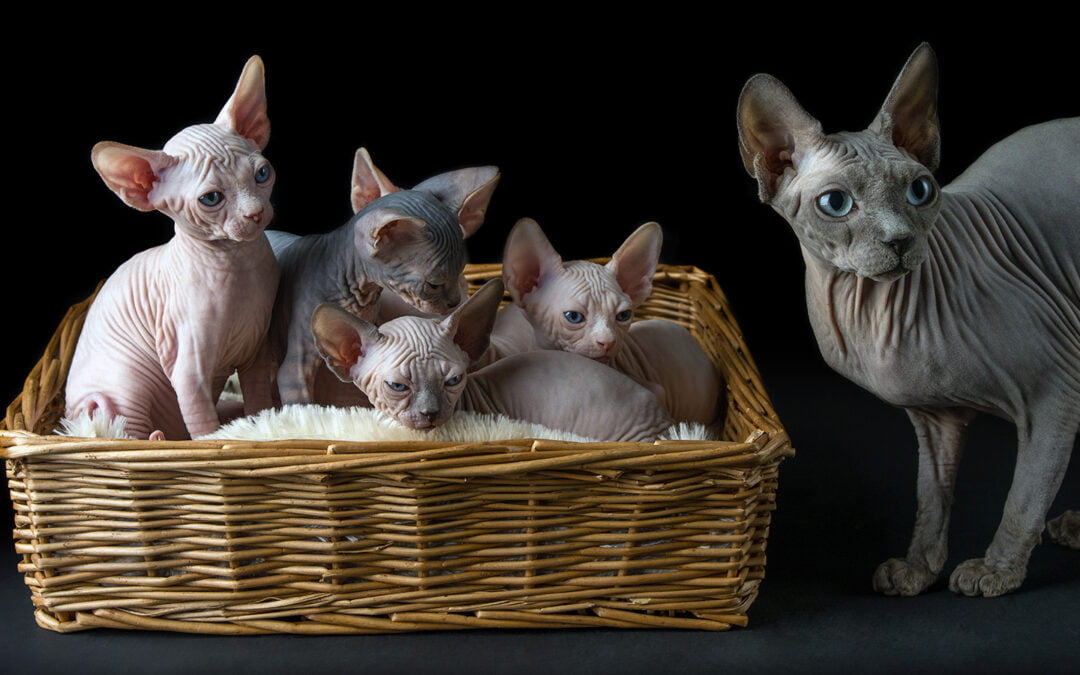
by Margejane | Cat Health
Sphynx cats are those adorable, wide-eyed cats notable for their hairless bodies and beautiful big eyes.
Some interesting facts about sphinx cats:
- They are goofy felines who love to play and sometimes act more like dogs than cats
- Sphynx cats are originally from Canada (did you think they were from Egypt? I did!)
- They love to sunbathe and snuggle with their owners under blankets – no9surprise since without lots of furs they need to keep warm!
- Sphynx cats average 6-12 pounds in weight and live an average of 9 to 15 years.
- Coat colors are numerous, including but not limited to white, black, chocolate, and calico.
- The highly affectionate, high energy Sphynx is very playful and loves to “talk.”
- Originally called the Canadian hairless, the Sphynx is an increasingly popular pet in the U.S.
I hope you enjoyed those interesting facts about Sphynx cats – and now, onto their care!
Grooming is extremely important even though this breed has no real fur. Because they have no fur, they cannot absorb their body oils and require regular care to maintain a healthy balance of oil and prevent skin problems and oil spots on your furniture.
It’s important to bathe your sphinx cat at least once a week in order to remove oil build-up. You need to be sure to scrub in between their many wrinkles and folds as well.
Although sphinx cats look entirely hairless, they are actually covered in a very fine suede-like coat, which means they’re not 100% hypoallergenic, but physicians do recommend this breed to people who want a cat. If a person is only allergic to animal hair, but not dander or oil, the sphinx may be the perfect pet.
Because of their lack of hair, the sphinx is sensitive to sun exposure – they don’t have any protection from harmful UV rays. They should have only a limited amount of sun. These cats can get a sunburn just like us humans! These cats should be indoor pets only (which as you well know, I strongly advocate all housecats be indoor cats for their own safety.)
Sphynx Cats can be prone to hypertrophic cardiomyopathy, which is a common heart disease-causing heart muscle thickening.
They can also be prone to periodontal disease or gum disorders. In addition to weekly baths, tooth brushing is very effective to prevent these problems. You may be saying “OMG, how the heck can I brush my Sphynx’s teeth?”
Fear not dear readers, here is information on how to brush your cat’s teeth (and it doesn’t have to be a Sphynx to brush their teeth.)
How to Brush Your Cat’s Teeth
Going over the top of your cat’s head while standing behind the cat, gently stroke and massage your cat’s face. If he backs off and/or seems upset, STOP. You don’t want to be bitten or scratched.
Put a little cat toothpaste on your finger and see if your cat likes the toothpaste. If he does, hold your cat by putting your hand around her lower jaw and top of her head. Rub your cat’s teeth with your finger with a little toothpaste for a few days; then use a toothbrush (get one at your local pet shop) and brush gently – do this 2-3x a week.
I hope this information helps all my Sphynx loving readers! Feel free to leave your questions and comments below…I love hearing from you!
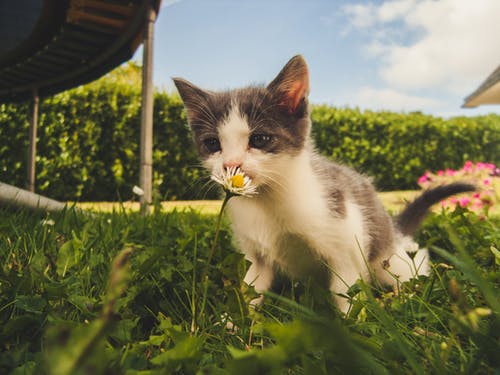
by Margejane | Cat Health
One of the most important factors to consider when choosing either of these pets is the amount of time that would be dedicated to the pet.
Dogs need much more attention than cats do. A cat does not need your constant reassuring cuddles or treats to remind them of your love, as long as they receive good care. The main thing a cat is passionate about is getting more treats and being fed on time.
If you own an outdoor cat (which we highly recommend against) then you might as well consider yourself having a wayward pet who comes and goes whenever they please.
Ever seen anyone taking a cat for a walk? It happens, but rarely. A dog would always want to be around its owner for the petting, cuddles, treats, kisses (yes, you read that right) and more importantly, the words of affirmation, “GOOD BOY”.
When considering picking between these lovely pets, ask yourself this – “Am I emotionally and physically available fort constant cuddles or do I want a semi-independent pet that does not need constant attention?”
You must have already concluded that our furry canine friends are more expensive to care for than their feline compadres. Searching your pockets for the amount of love (money) you can offer may steer your heart in the right direction towards choosing the perfect pet.
Although the heart may want what it wants, the pocket can only offer what it has.
Cats are generally less expensive to own than dogs. They groom themselves, ideally stay indoors and need less food. In fact, attempting to bathe a cat is an extreme sport. What cats save on monetary costs, they often make up for by being less needy than dogs.
Ever hear of therapy cats? I thought not. Cats tend to have a longer life expectancy rate on an average of 12-14 years and can live till their 20s. However, dogs have an average lifespan of 7-14 years and legend has it that the oldest dog lived up to 29 years (and was most likely friends with a couple of cats.)
DOG PEOPLE VS CAT PEOPLE
Dog and cat people may have good reasons for their personal preference. This disagreement stems solely from the position that one pet makes a better companion than the other. Now, as I said earlier, the heart wants what it wants. These two sets of pet lovers want what they want for all the right reasons.
CASE FOR TOP DOGS
First, while cats may play with the owner every now and again, dogs are the brightest bulbs in the room whenever they see their owner (or best friend.) Dogs are always willingly and readily available to engage in any kind of game for as long as you want.
They are easy to train and teach different tricks. Some dogs are even trained to do actual jobs for their owners. This makes them quite useful to have around.
Second, dogs are easier to adapt to new environments than cats are. They usually are fond of their owners and may not care where they are as long as they will be with their owner (or best friend.) This makes a strong case for dogs as they care for you only, irrespective of where they might be. They just love being around you ALL the time.
Lastly, dogs will always put up a protective wall whenever they sense danger or feel you are threatened.
A dog’s first reaction to the owner being threatened is to come to the rescue, while a cat would rather hide and save its skin (or purrs if you will.) The dog’s sense of smell also comes in handy.
Dogs can even sense when an epiIeptic owner is about to have a seizure, and help them through it.
COOL CATS
As their street name implies, cats are cool, calm and collected quiet creatures, who usually spend 80% of their time sleeping. Even if cats are feeling the need for attention, their meows are still not as loud as the barks from dogs.
Cat people often prefer a serenely quiet and calm environment as compared to dog people. And it certainly is a great advantage to not have to walk a cat in the freezing winter or hot summer! Second, cats are less expensive to maintain as stated earlier.
Not saying cat people are broke people or anything (lol) but it is convenient. The fact that they do not need you for much is just a testament to the convenience level attached to being a cat owner.
Lastly, these feline creatures are the most independent domestic animals. Some cats seldom make themselves available for love and care while others want your constant attention.
They may rub against your leg or climb onto your bed once in awhile but only but only when they feel like it. And cat people are comfortable with that.
Whatever pet you may prefer (and with this website, you know cats are #1 in my book) we can all agree that they are awesome companions!
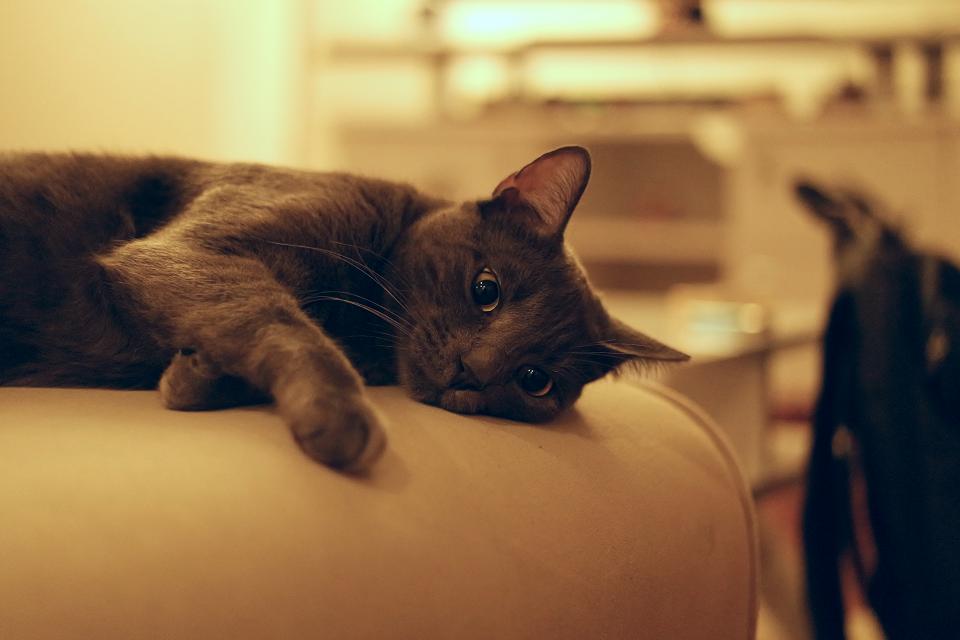
by Margejane | Cat Health
Ringworm in cats is an infection of the skin, hair or claws that is caused by a fungus known as a dermatophyte. Dermatophytes grow only in the dead cells of skin and hair. The infection stops on reaching living cells or inflamed tissue. The name ringworm can prove to be very misleading, as it’s not caused by a worm, and the lesions are not always ring-shaped.
Some species of dermatophytes are species-specific, meaning they will only infect one species, while other types can be spread between different species of animals or from animals to humans.
One species called Trichophyton mentagrophytes is zoonotic, meaning it can also infect humans. Ringworm’s appearance varies in cats, with kittens most likely to be infected.
About Ringworm
The incubation period from exposure to development of ringworm lesions can range from 7-14 days and sometimes 21 days before signs of infection develop.
The affected areas can develop into small, solid bumps on the skin (miliary dermatitis) that can be very itchy. Infected cats can have bald, scaly crusted patches and broken hairs.
However, it is sometimes difficult to detect ringworm in cats as the lesions may be very mild or even undetectable. Sometimes the only visible indicator of ringworm is a “cigarette ash” scaling in the depths of the cat’s coat. Sometimes the cat may suffer from hair loss.
However, since there are numerous reasons for a cat to suffer hair loss, your veterinarian will need to test for the cause to see if it truly is ringworm.
This is done by taking a culture of the fungus using hair and skin scrapings. The results can take anywhere from a couple of days to four weeks if it is a slow growing fungus.
Ringworm may also be diagnosed by using a special ultraviolet lamp, a Wood’s lamp, because the majority of feline ringworm cases caused by M. canis will glow a yellow-green fluorescence when examined in a dark room using this lamp.
Ringworm is contagious for the first 48 hours of treatment in people and approximately three weeks after starting aggressive treatment in pets.
Treating Ringworm
Treatment of ringworm is always necessary so as to minimize the risk of spreading the infection to humans, especially children and other pets.
Ringworm is a self-limiting infection in many cases, taking about 5-7 months to resolve. There are topical treatments; creams and lotions are available that can be applied to localized areas of affected skin.
Topical treatment usually takes several weeks or months. A great all-natural product is Oxy-Cat – it can be used both topically and added to food! Best of all, it really works. You can check it out at here.
If you are bathing your cat, please be sure to wash your hands (lather for a full 20 seconds minimum before rinsing) and sanitize the surfaces kitty has come in contact with using a bleach solution. Mix one pint of chlorine bleach in a gallon of water.
Oral treatment maybe recommended by your veterinarian. Griseofulvin is used a great deal for this condition. Other antifungal medications include itraconazol or Lamisil, which have fewer side effects.
A six week regimen is typical, and it is important to use whatever treatment you administer for the fully recommended time to avoid recurrence.
ENVIRONMENTAL CLEANING
It’s extremely important to isolate the affected cat – kitty has infected hairs that contain numerous microscopic fungal spores, and these can be shed into the environment.
It’s best to keep kitty in a room that is easy to clean, such as an extra bathroom. By trimming kitty’s hair (being extremely careful to dispose of the hair in a sealed plastic bag, for example) combined with topical treatment with antifungal medication can help to reduce environmental contamination.
Vacuum floors, carpeting, and furniture to help eliminate fungal spores.
If any people in the house develop skin lesions such as thickened skin with raised scaly edges, one should see a doctor as soon as possible. While this is easily treatable, the ringworm fungus can remain infective for up to 18 months and there could possibly be reinfection. Always wear
gloves when you are in contact with infected animals and wash your hands very thoroughly afterward.
I hope this information will be of help to you, my valued readers!
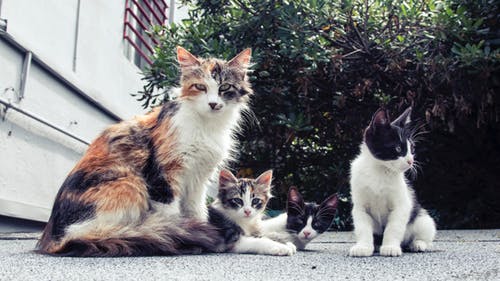
by Margejane | Cat Health
Fleas have got to be one of the most disgusting and upsetting things to deal with. These insects not only make your pets crazy with itching, but they can also bite the people in your family as well. They can literally infest everything in your home.
Some years ago I adopted a cat named Yogurt from a rescue group. I love all cats but have a special affection for torti cats, so seeing her sweet little face on Petfinder.com convinced me she had to join my little family. I have had cats all my life and never had a flea problem before, but to my horror, I discovered that Yogurt was infested with the darn things.
I tried every commercial product on the planet but could not eliminate the problem, and I was very concerned that the chemicals used in these products would harm both myself and my other cat as well as Yogurt.
Thankfully I found a product that was totally non-toxic and could get rid of the fleas. It worked by blocking the fleas’ respiratory system, in effect suffocating them. Within a day’s treatment, the fleas were gone from both my cats and my home. I’d been getting flea bites when I went to bed at night, and one treatment of my mattress stopped that completely.
I am confident this product will not only solve your flea problem but also is effective against ants and other pests we get in the summer.
It’s got a money-back guarantee!
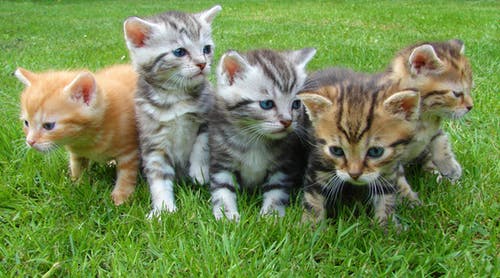
by Margejane | Cat Health, Featured
FIP, feline infectious peritonitis (FCoV) is a virus of the gastrointestinal tract. The majority of infections are either asymptomatic (no symptoms) for months or even years, or cause diarrhea.
This is very common in kittens whose maternally derived antibody decreases between 5 and 7 weeks old. The majority of cases are most prevalent in cats younger than 3 years old, and especially in kittens 4 to 16 months old.
The virus is most common where there are large groups of cats living in the same house sharing food and water dishes. Using contaminated litter scoops can transmit infected microscopic cat litter particles to uninfected cats and kittens.
Other means of ingesting or transmitting FCoV is inhaling the virus when it is shed in feces, which happens when litter boxes are shared. Another method of transmission is through different body fluids, easily spread by direct contact between cats, most commonly when an infected cat grooms an uninfected cat and the infected saliva remains on the uninfected cat. When the healthy cat grooms himself he will ingest the virus.
There are 2 types of FIP:
- Effusive (wet) FIP – the clinical sign of effusive FIP is fluid accumulating in the chest or abdomen. This can cause breathing difficulties. The cat may also experience loss of appetite, fever, diarrhea, jaundice and weight loss.
- Non-effusive (dry) FIP – Symptoms of dry FIP are the same as with wet FIP, but there is no fluid accumulation. The cat may have difficulty standing up or walking, eventually becoming paralyzed. Blindness may also occur.
Your veterinarian has multiple tests to determine if your cat is suffering from a form of FIP.
While FIP is considered fatal, there are antiviral drugs that have proven promising, such as experimental drugs, GS-441524, and GC376. As of this writing, these drugs were not yet commercially available.
Felocell is an intranasal vaccine for healthy cats 16 weeks and older to help prevent cats from contracting FIP. It is available in the U.S.
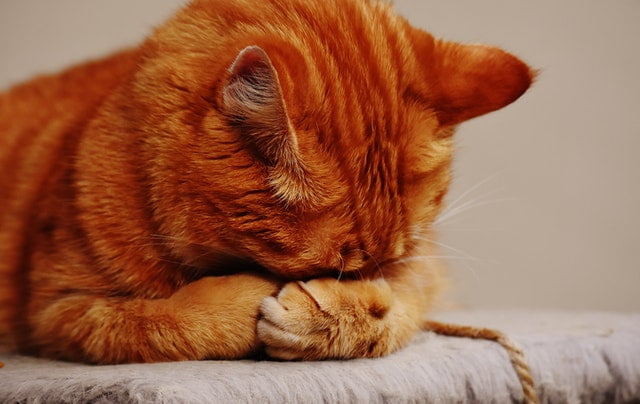
by Margejane | Cat Health
- PREPARING FOR KITTY’S ARRIVAL
So the big day has come when you are going to welcome your new kitten into your home. It is an exciting time, but it can also be a bit stressful for you and your kitty if you are not prepared. In this article, you will find some important tips to make it easier for your kitten to adapt well to your new home and family.
- Kittens are curious by nature, but they can also feel a little insecure when they arrive at their new home, so it is important to create a safe environment for them. The easiest way to achieve this is to prepare one room, preferably a spare bedroom or bathroom. The room should be equipped with a litter box, food, water, and cat toys. Your kitty may want to have somewhere to hide and escape, so it’s a good idea to prepare a covered basket or a simple cardboard box with a comfortable blanket over a pillow inside.
- It’s important to think about all those things that might tempt your kitty to investigate – scissors, string, rubberbands…things that kitty could choke on or get cut by.
- Many houseplants are toxic, so please be sure to keep plants where you are certain kitty cannot get access.
- Another basic investment you should make is to buy a scratching post and one or two scratching boards. It’s a good idea to keep a scratching board in each room that doesn’t have the scratching post. Rub some catnip on each one (most scratching boards come with some.) If you catch kitty scratching elsewhere, a firm “no” and then take the kitty to the scratching post or board and hold his paws and show him how to use it. Never ever hit or punish kitty.
- To socialize a new kitten, take a small blanket or towel and wrap your kitten in it and hold him close to you. Hold him gently but firmly, even if he squirms a lot, don’t let him go too fast, hold him for as long as possible so he gets used to the human contact. Eventually, he will get used to and enjoy this human contact.
- Cat toys – great cat toys include the “fishing rod” type, toy balls, toys stuffed with catnip, the plastic rings from milk jugs, and of course empty boxes. Kittens do love to play with string and ribbons, but please be sure to put these away when you cannot supervise, as kitty may try to swallow them and they do post a choking hazard.
Finally, the most important thing is that you have a good time! The process of getting to know and establish a bond with your pet is probably the best part of having a companion cat.
Page 3 of 7«12345...»Last »







Recent Comments